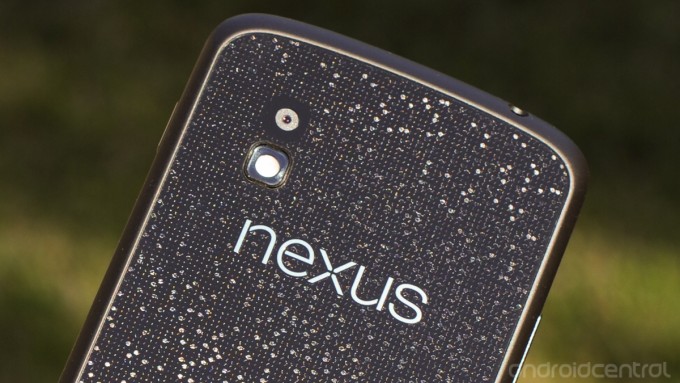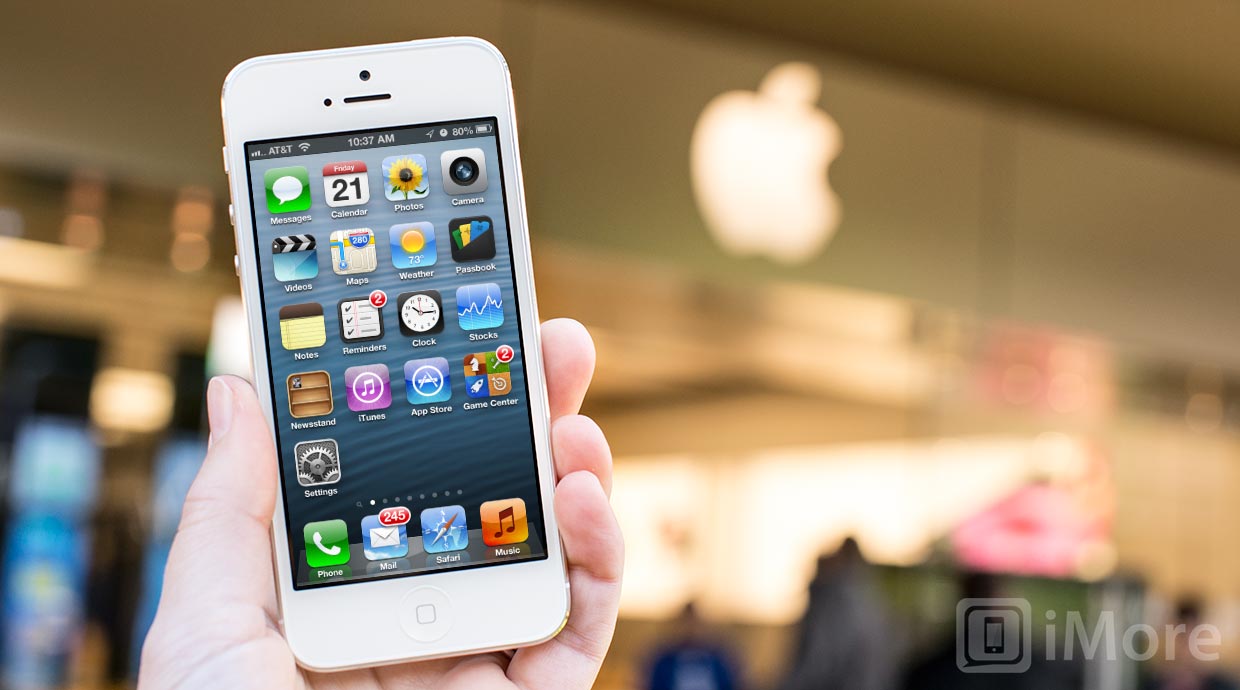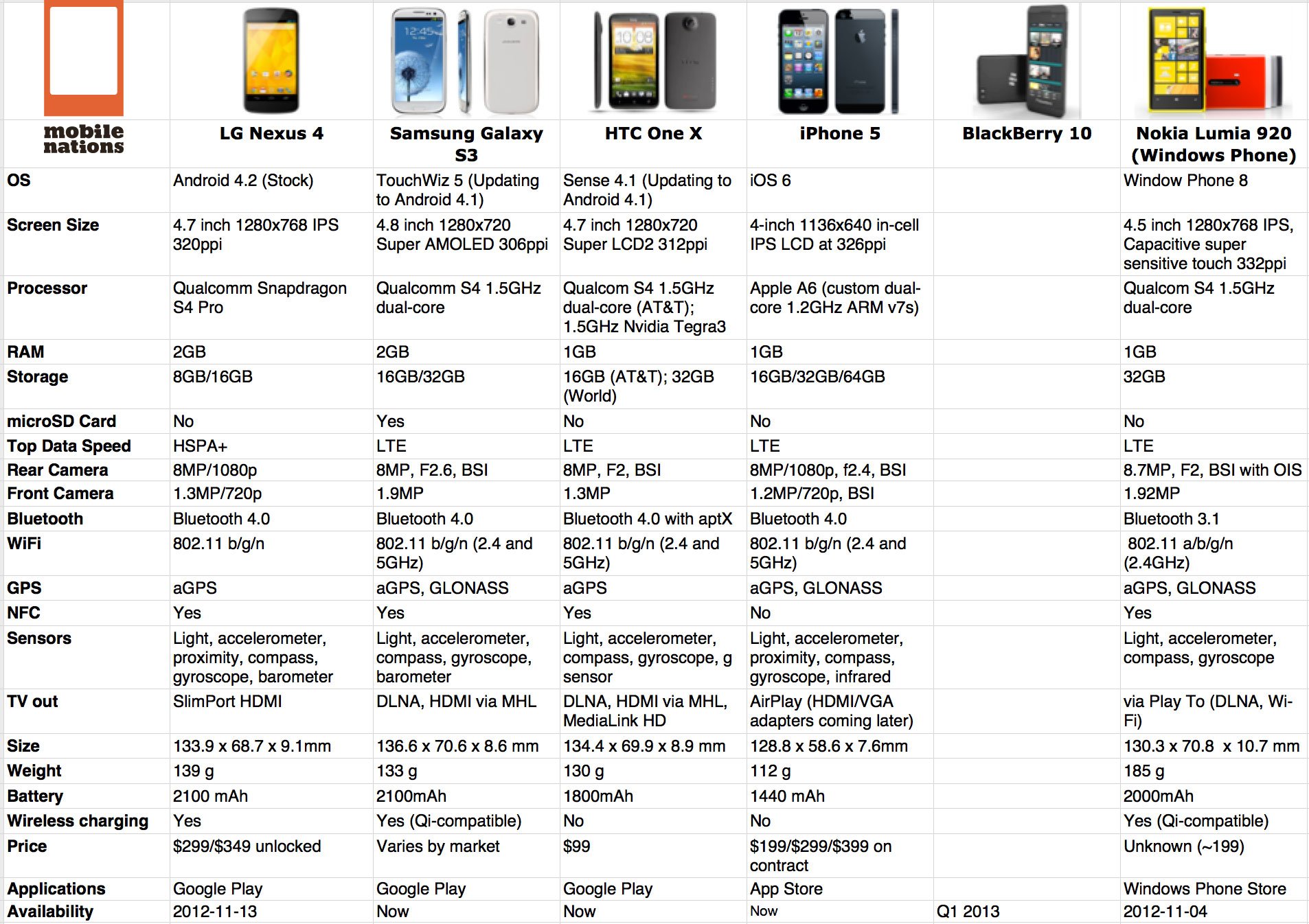iPhone 5 vs. Nexus 4: Which phone should you get?

Apple has released the taller, thinner, faster, lighter, brighter iPhone 5 and now Google has struck back with the LG Nexus 4. So what's a gadget geek to do? Apple owns the patent (we think maybe literally...) on elegant, futuristic hardware, consumer-friendly software, and the top content service in the world. Google and LG have brought almost every spec you can imagine (and a few you couldn't!), have the most powerful, customizable software, and the best internet services on the planet. How can you possibly decide between them?
Let's take a look...!
Google/LG Nexus 4

LG starts the Nexus 4 off with a massive 4.7-inch IPS display at 768x1280. That's essentially 720p with its belt let out. The sides are soft-touch, and the back is fully decked out in something called Crystal Reflective Process, which makes it look like you're holding a star field in your hand. There's an 8 megapixel, 1080p camera on back that shames the rather poor shooter on Samsung's last-generation Galaxy Nexus, and a 1.3 megapixel, 1080p camera on the front. A monstrous Qualcomm Snapdragon S4 Pro processor powers the whole thing, but while it has all the usual Wi-Fi, Bluetooth, and NFC radios you'd expect, so far there's absolutely no LTE version in sight.
Android 4.2 shares the same Jelly Bean code name as it's predecessor, but comes with a few great new features like Photosphere which wraps panoramas around you. There's also be lock screen widgets, an improved Gmail app, fast access to radio toggles, and since it's a Nexus, easy access to developer settings. That goes along with all the other marquee Jelly Bean features like the Google Now voice assistant and actionable notifications. Pretty much everything that makes Android so powerful, flexible, and customizable.
In the Nexus 4 review Phil Nickinson of Android Central summed it up like this:
The Nexus 4, LG's first phone in Google's premier line, easily is the best "stock" Android phone thus far, and it's the best in the Nexus line since HTC's Nexus One. The hardware is more top-of-the-line than we're used to in the Nexus platform. The design improves on what LG's done with its own Optimus G. And the software improvements in Android 4.2 make the platform that much more impressive. The phone's not without compromise, but it's also an easy phone to recommend, especially for the price.
The Nexus 4 comes in 8 and 16GB versions. If you buy it direct from Google, you can get it unlocked for $299 or $349. If Google doesn't sell (read: subsidize) it in your area, however, you're looking a paying a bunch more.
- Complete Google/LG Nexus 4 review
- Android 4.2 Jelly Bean features
Apple iPhone 5

The iPhone 5 has a newly re-designed unibody aluminum chassis to allow for a bigger 4-inch screen in a phone that's 12% smaller by volume. It's taller but not wider, thinner and also lighter. That 4-inch screen also uses in-cell technology to combine the touch sensor right into the LCD. At 1136x640 and 326ppi, it's still backlit LED, and still IPS, and technically the best, most advanced panel on the planet for now. Apple also rolled their own, manually-set Apple A6 processor this time, based on ARM v7s, for amazing performance and excellent power management. There's still no NFC, but there is CDMA, HSPA, and international LTE.
Master your iPhone in minutes
iMore offers spot-on advice and guidance from our team of experts, with decades of Apple device experience to lean on. Learn more with iMore!
iOS 6 comes loaded on the iPhone 5, and includes a new, controversial Maps app, some great extensions to Siri, deep Facebook integration, Passbook, and enhancements to FaceTime, Mail, Safari, Photo Stream, Panorama, and Accessibility. And because Apple makes both the hardware and the software, there's no integration, no added interface layers, and a seamless experience overall.
iTunes has the biggest international content footprint, so if you're into buying your music, TV, and movies, there's a better chance Apple will take your money than anyone else. They also have the free iCloud service for backup, restore, and sync, as well as Apple Retail Stores with Genius Bars which, if you ever break your phone, you'll absolutely consider a killer service.
In the iPhone 5 review, I summed it up as follows:
Taller, thinner, faster, lighter, brighter; the iPhone 5 represents nothing more nor less than the latest, relentless iteration on the Platonic ideal Apple has been striving towards for almost a decade. Redesigned in every way but shape, compromised but true to its purpose, the iPhone 5 is once again the best iPhone Apple has ever made, and one of the best phones ever made. Period.
The iPhone 5 comes in 16, 32, and 64GB versions. The price on-contract is $199, $299, and $399, unlocked and off-contract is $650, $750, and $850.
Apple iPhone 5 vs. Google/LG Nexus 4: The bottom line

The story of iPhone and Android is one of those classics that just seems to keep getting remade. It's one of precision vs. power, elegance vs. enormity, usability vs. customizability, and Apple's ecosystem vs. Google's ecosystem.
The Nexus 4, if you have a Google Play Store in your country and can buy it directly, is the best bang for the buck in high-end smartphones these days. (Although you'll still end up paying for your carrier plan, basically making any device savings irrelevant.) However, it won't come with more than 16GB of storage, and it won't come with LTE. (And don't let them fool you, I get 50Mbps down at the local coffee shop, HSPA+ is lucky to get half that.) As of right now, however, the Nexus 4 is pretty much the ultimate Android developer/tweaker phone.
The iPhone 5 is more expensive, but it's also built, glitter aside, like nothing else on the planet. You can get it with up to 64GB of storage and with LTE in most places that have LTE. And for most people, most of the time, iOS and everything that comes with it remains the best choice. The iPhone 5 is still king of the mainstream.
The old cliche remains true. If you want something that works the way you want it, get the Nexus 4. If you want something that just works, get the iPhone 5.
More help
Need more help choosing between the iPhone 5 and the Nexus 4? Here's where you can have your questions answered!

Rene Ritchie is one of the most respected Apple analysts in the business, reaching a combined audience of over 40 million readers a month. His YouTube channel, Vector, has over 90 thousand subscribers and 14 million views and his podcasts, including Debug, have been downloaded over 20 million times. He also regularly co-hosts MacBreak Weekly for the TWiT network and co-hosted CES Live! and Talk Mobile. Based in Montreal, Rene is a former director of product marketing, web developer, and graphic designer. He's authored several books and appeared on numerous television and radio segments to discuss Apple and the technology industry. When not working, he likes to cook, grapple, and spend time with his friends and family.
